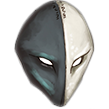There are a number of important terms that you'll need to know as you create your first character or adventure. Some of the most important terms mentioned on previous pages are also included here for reference.
During encounters, each creature gets three
actions during their turn. These actions are spent to attack, interact with objects, move, and use special abilities. Actions available to all characters can be found in
Chapter 8.
An ancestry is the broad family of people that a character belongs to. Ancestry determines a character's starting
Hit Points,
languages,
senses, and
Speed, and it grants access to ancestry feats. Ancestries can be found in
Chapter 2.
All creatures in the game have an
Armor Class. This score represents how hard it is to hit and damage a creature. It serves as the Difficulty Class for hitting a creature with an attack.
When a creature tries to harm another creature, it makes a
Strike or uses some other attack action. Most attacks are Strikes made with a weapon, but a character might Strike with their
fist,
grapple or
shove with their hands, or attack with a
spell.
Each creature has six attribute modifiers: Strength, Dexterity, Constitution, Intelligence, Wisdom, and Charisma. Each of these numbers represents a creature's raw potential and general training. Attributes are described in full
later in this chapter.
A background represents what a character experienced before they took up the life of an adventurer. Each background grants a feat and training in one or more skills. You can read more about backgrounds in
Chapter 2.
Bonuses and
penalties apply to checks and certain statistics. There are several types of bonuses and penalties. If you have more than one bonus of the same type, you use only the highest bonus. Likewise, you use only the worst penalty of each type.
When a character attempts an action where success is uncertain, they may roll a
check. This is a roll of one twenty-sided die plus the named proficiency bonus. For example, a
Perception check would add your Perception proficiency.
A class represents the adventuring profession chosen by a character. A character's class determines most of their proficiencies, grants the character Hit Points each time they gain a new level, and gives access to a set of class feats. Classes appear in
Chapter 3.
An ongoing effect that changes how a character can act, or that alters some of their statistics, is called a condition. The rules for the basic conditions used in the game can be found in the
Conditions Appendix at the back of this book.
The most common currencies in the game are gold pieces (gp) and silver pieces (sp). One gp is worth 10 sp. In addition, 1 sp is worth 10 copper pieces (cp), and 10 gp are worth 1 platinum piece (pp). Characters begin play with 15 gp (or 150 sp) to spend on equipment.
A feat is an ability you can select for your character due to their ancestry, background, class, general training, or skill training. Some feats grant the ability to use special actions, while others make your existing actions more effective.
The Game Master is the player who adjudicates the rules and narrates the various elements of the Pathfinder story and world that the other players explore. The GM uses the rules found in
Pathfinder GM Core.
Pathfinder is set on the planet Golarion during the Age of Lost Omens. It is an ancient world with a rich diversity of people and cultures, exciting locations to explore, and deadly villains. More information on the Age of Lost Omens, the world of Golarion, and its deities can be found on
here.
Hit Points represent the amount of punishment a creature can take before it falls
unconscious and begins
dying. Damage decreases Hit Points on a 1-to-1 basis, while healing restores Hit Points at the same rate.
At the start of an encounter, all creatures involved roll for initiative to determine the order in which they act. The higher the result of its roll, the earlier a creature gets to act. Initiative and combat are described in
Chapter 8.
A level is a number that measures something's overall power. Player characters have a level, ranging from 1st to 20th, representing their level of experience. Monsters, NPCs, hazards, diseases, and poisons have levels ranging from –1 to 30 that measure the danger they pose. An item's level, usually within the range of 0 to 20 but sometimes higher, indicates its power and suitability as treasure.
A nonplayer character, controlled by the GM, interacts with players and helps advance the story.
Perception measures your character's ability to notice hidden objects or unusual situations, and it usually determines how quickly the character springs into action in combat. It is described in full in
Chapter 8.
This is a character created and controlled by a player.
Proficiency is a system that measures a character's aptitude at a specific task or quality, and it has five ranks: untrained, trained, expert, master, and legendary. Proficiency gives you a bonus that's added when determining the following modifiers and statistics: AC, attack rolls, Perception, saving throws, skills, and the effectiveness of spells. If you're untrained, your proficiency bonus is +0. If you're trained, expert, master, or legendary, your proficiency bonus equals your level plus 2, 4, 6, or 8, respectively.
Some elements of the game have a rarity to denote how often they're encountered in the game world. Rarity primarily applies to equipment and magic items, but spells, feats, and other rules elements also have a rarity. If no rarity appears in the traits of an item, spell, or other game element, it's of common rarity.
Uncommon options are available only to those who have special training, grew up in a certain culture, or come from a particular part of the world. This can be explained with an “Access” entry, explaining criteria for characters to choose it as a common option.
Rare options are almost impossible to find and are usually given out only by the GM, while
unique ones are literally one-of-a-kind in the game. The GM might alter the way rarity works or change the rarity of individual items to suit the story they want to tell.
Describing a character's actions, often while acting from the perspective of the character, is called roleplaying. When a player speaks or describes action from the perspective of a character, they are “in character.”
A round is a period of time during an
encounter in which all participants get a chance to act. A round represents approximately 6 seconds in game time.
When a creature is subject to a dangerous effect that must be avoided, it attempts a saving throw to mitigate the effect. You attempt a saving throw automatically—you don't have to use an action or a reaction. Unlike for most checks, the character who isn't acting rolls the d20 for a saving throw, and the creature who is acting provides the DC.
There are three types of saving throws: Fortitude (to resist diseases, poisons, and physical effects), Reflex (to evade effects a character could quickly dodge), and Will (to resist effects that target the mind and personality).
A skill represents a creature's ability to perform certain tasks that require instruction or practice. All characters are trained in certain skills due to their background and class. Skills are fully described in
Chapter 4. Each skill includes ways anyone can use that skill even if untrained, as well as uses that require a character to be trained in the skill.
Speed is the distance a character can move using a single action, measured in feet.
Spells are magical effects created by performing mystical incantations and gestures known only to those with special training or inborn abilities. Casting a spell is an activity that usually uses 2 actions. Each spell specifies what it targets, the actions needed to cast it, its effects, and how it can be resisted. If a class grants spells, the basics of that ability are provided in the class description in
Chapter 3, while the spells themselves are detailed in
Chapter 7.
Spells have ranks ranging from 1st to 10th, which measure their power; characters and monsters can usually cast only a certain number of spells of any given rank.
A trait is a keyword that conveys additional information about a rules element, such as which ancestry a feat belongs to or the rarity of an item. Often, a trait indicates how other rules interact with an ability, creature, item, or another rules element that has that trait.
All the traits used in this book appear in the Glossary and Index beginning on page 452. The traits page on Archives of Nethys can be found
here.
During the course of a round, each creature takes a single turn according to initiative. A creature can typically use up to three actions during its turn.
 Licenses
Sources
Licenses
Sources
 Contact Us
Contributors
Support the Archives
Maximize Menu
Contact Us
Contributors
Support the Archives
Maximize Menu
 Licenses
Sources
Licenses
Sources
 Contact Us
Contributors
Support the Archives
Contact Us
Contributors
Support the Archives









